Making digital magazines for your business can be fast and easy if you have the right tools at hand. Whether you want to create simple or fully monetized content, digital magazine software will help you do the job. So check out our list of the best digital magazine software for any level of skill and choose whatever suits you most. But first, read about the top features of the best magazine platforms.
Features to Look for in Digital Magazine Software
When choosing digital magazine software, there are several key features to consider to ensure that the platform meets your needs and provides a good experience for your readers. Here are some of the essential features:
🧑💻User-friendly interface: the software should have an intuitive and easy-to-navigate interface for both you (the publisher) and your readers. User-friendly features also ensure that even those with little technical knowledge can create digital magazines.
📱Responsive design: the online magazine should display well on various devices, including desktops, tablets, and smartphones.
🗂Content management system (CMS): the online magazine software should have a robust CMS that allows for easy uploading, editing, and organizing of content.
🎨Customization options: look for software that allows you to add your own branding so that your magazine aligns with your company's identity.
🎬Multimedia support: the ability to incorporate multimedia elements like videos, audio, and GIFs can enhance the reader experience.
📈SEO and analytics: tools for search engine optimization (SEO) and detailed analytics to track reader engagement and behavior are important for growth and improvement.
💰Subscription and monetization options: if you plan to monetize your magazine, look for software that supports various subscription models, paywalls, and advertising opportunities.
🫶Accessibility features: ensuring that the software is accessible to people with disabilities, including screen reader compatibility and adjustable text sizes, is important for inclusivity.
🛠️Technical support and reliability: reliable customer support and software with minimal downtime are crucial for maintaining a professional presence.
⚖️Compliance with standards: the software should comply with legal and industry standards, including data protection regulations.
The right digital magazine software makes publishing simple, fun, and seamless for you and your readers. Choose a platform that’s easy to use, works beautifully on any device, and lets you showcase your brand and content at their best.
#1 FlippingBook
FlippingBook is digital magazine software that allows you to convert plain PDFs to interactive flipbook magazines and publish them online as links straight away. A magazine created with FlippingBook is a powerful, branded interactive document that helps you achieve many marketing goals at once. Flippingbook magazines look fresh and engaging, so you’re sure to catch your readers’ attention and drive traffic to your content from all of your marketing platforms. And advanced analytics helps you track how your content performs and make informed decisions to enhance your magazines and be even more efficient.
Plus, such a magazine can become a great lead generation tool thanks to its built-in customizable lead capture form. You’ll have all your leads in one handy dashboard and will be able to build a connection with them right away. And thanks to Zapier integration, you can pass the leads straight into your CRM or Google Sheets list for easier management.
So, if you’re looking for a marketing one-stop shop that allows you to create professional-looking magazines, an online page flip magazine software like FlippingBook is your best choice.
Just check out how bright and rich the pages of this magazine look, you simply want to go traveling right away!
Key benefits:
Interactivity: offer a variety of formats to create an immersive experience with your magazines. Boost engagement with your content by adding videos, explain complicated concepts with GIFs that are fun and easy to understand, show imagery from a new angle or provide additional data in your pop-up images and galleries, add interactive forms and quizzes to gather valuable insights or know your audience better, and refer to useful sources by adding outbound links.
Easy distribution: reach a wider audience and get new clients by sharing your magazines across all of your marketing channels—via direct links or QR codes, embedding into your website, posting on social media, or sending via email.
Branding: creating a consistent brand image across your content can improve revenue by up to 23%. FlippingBook allows you to add your company logo, your own background and company colors, and fully customize the link to reflect your brand.
Document tracking: get actionable data to improve both the content and the communications with your audience. Know how many people have read your latest issue, how much time they’ve spent on it, and even what pages they’ve found especially interesting.
Canva integration: Thanks to FlippingBook and Canva, you can seamlessly proceed from creating a PDF to making and customizing your flipbook. Create a Canva design from scratch and then publish your design to FlippingBook right from your Canva account without going anywhere. FlippingBook also offers 10+ specially designed Canva templates to get you started.
#2 Publuu
Publuu is digital magazine publishing software that allows you to customize your content by choosing your custom colors or one of many designs, brand your online magazines with your logo, and add animated hotspots with videos, photos, or links. You can also display your magazines on an online newsstand or publish them on your customized mobile app. So if you’re looking for online magazine publishing software that lets you customize your magazines to your liking and distribute them through mobile apps, Publuu might be the tool that you need.
Key benefits:
Web & app kiosk: display your content at its best by publishing your online magazines on your own custom-designed website and mobile application, available to download from Google Play and App Store.
Magazine statistics: know your audience by checking how much time your readers spent on each page of your online magazine, which one was the most interesting for them, and how people interacted with them.
Website embedding: make your magazines fully visible or set them as smart, clickable buttons on your website. Choose their size and background color, and add your logo.
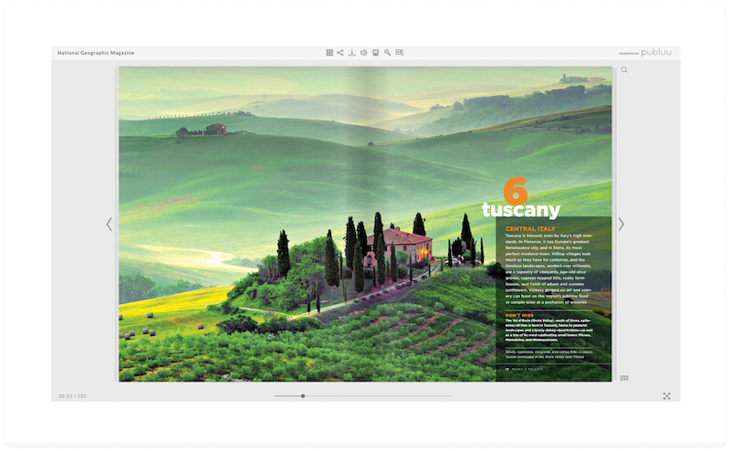
#3 MagLoft
MagLoft is magazine creation software that helps you build mobile apps for bloggers, publishers, and enterprises, and publish digital magazines online in all the major app stores. You upload your content (PDF, EPUB, ADOBE) or use one of their responsive HTML5 themes to create PDF magazines online, add analytics, push notifications, in-app pages, and more. When your content is ready, MagLoft takes care of all the technical requirements—from building the app to submitting it to Google Play and App Store. If you want to build publishing apps, create documents in them, and have many options for sharing your content, then such an online magazine platform as MagLot is just what you need.
Key benefits:
Content monetization: get more revenue from your magazines by selling individual issues and subscriptions using In-App Purchases features on Google Play Store, Apple App Store, and Amazon Store.
Articles and collections publishing: grow your traffic, readers, and revenue by publishing articles independently or as part of a collection. You can offer content as paid issues, lead magnets, or for free.
Drag & drop content editor: build interactive content with ease by using a visual drag-and-drop editor to create experiences that fit perfectly on any screen size and orientation.
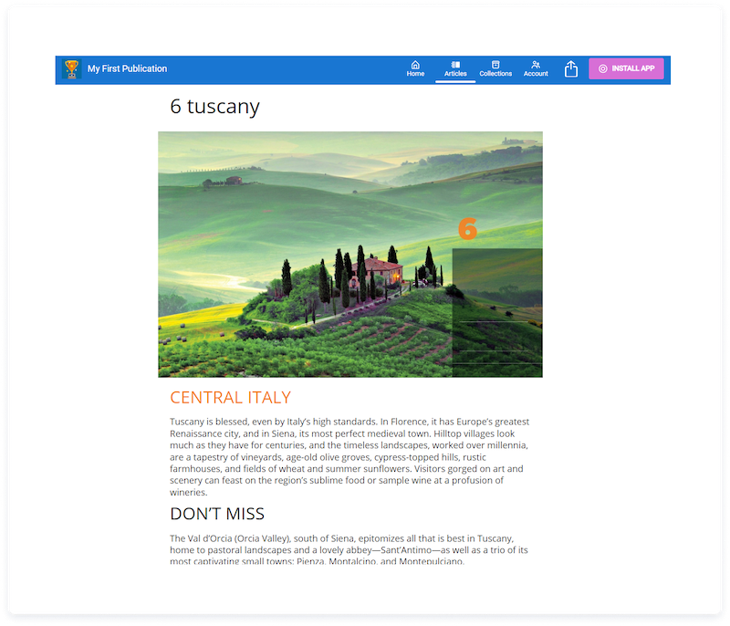
#4 Joomag
With this magazine maker software, you can create your publication by choosing from ready designs or uploading a PDF file. You can also add photo galleries, videos, and feedback forms to make your content more interactive. Joomag provides the simplest PDF viewer, compared to other tools—it has a slide mode by default and it’s quite hard to find an option to manually switch on the page-turning option. This PDF to magazine software also enables you to make multiple subscription packages and sell digital subscriptions to your publications, hard copies, or individual issues. If one of your main purposes is to create and sell digital magazines, then check out this digital publishing platform for magazines.
Key benefits:
CRM: Manage and deliver subscriptions from a single interface. Joomag’s CRM simplifies the subscription management process, allowing users to handle subscribers and send email blasts with ease.
Dynamic widgets: engage your readers and drive traffic to your website right from your online magazine. Add interactive surveys, calculators, charts, forms, minigames, and any other third-party widgets.
Selling digital magazines: use Joomag as a low-cost selling solution and sell single issues or subscriptions right from your website.
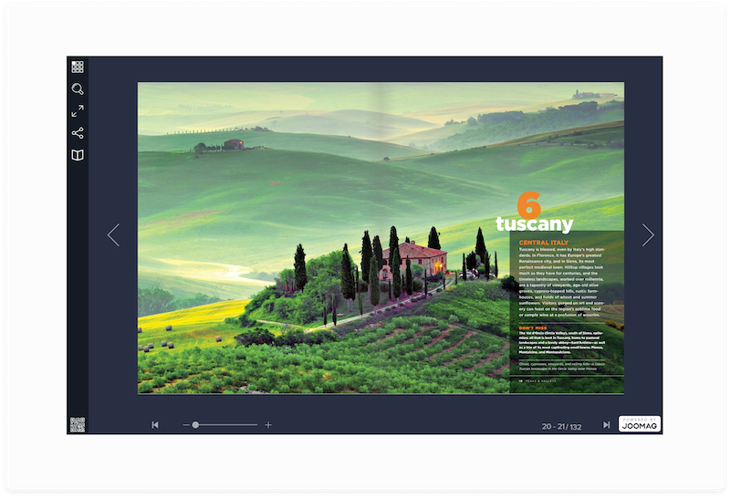
#5 Marq
With Marq, you can create multi-page layouts with customizable elements such as fonts, colors, and images, and use them when making your content step-by-step. Marq can be easily integrated with your favorite tools—you can transfer text from a Google Doc, insert photos from Dropbox, Facebook, or Unsplash to work faster and stay focused. If you want to upload a PDF, you can only do that through the image manager. This way, each page will be converted into a separate image, and you’ll have to select the ones you need to add to your design. So if you're mostly looking for digital magazine software with various integration options, then try Marq.
Key benefits:
Content distribution: reach your audience online and offline by publishing your magazine to the web, on social media, or sending any asset to print directly from Marq, with the option to set up custom printers, print and ship, and more.
InDesign integration: use your own professional designs by importing existing InDesign files and quickly converting them to brand templates. Share your newly created magazine templates with the teams that need them.
Brand assets: centralize all brand assets in one place. Add logo variations for easy access and specific use cases. Or upload approved imagery to your brand images folder that you can find in the editor.
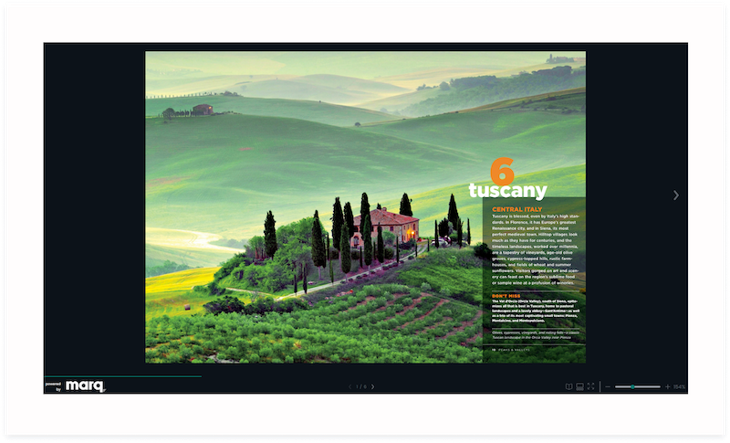
#6 Issuu
Issuu is online magazine publishing software that allows you to upload your PDFs, images, and text, and transform them into digital content using your own or Issuu’s layouts. You can also sell single issues or subscriptions of magazines, ebooks, and reports on your website or your social channels. And use Issuu analytics to drive revenue with advertisers. All in all, Issuu looks like an interactive social media platform for your magazines with ads and recommendations to read other content. Want to publish your magazines, distribute, and sell them through an online tool? Issuu can be the right ezine software for you.
Key benefits:
Online magazine monetization: generate revenue by selling your magazine using the premium Digital Sales feature with zero commission fees. You can also monetize your magazine with paid ad space, affiliate links, and shoppable pages.
Mobile articles: build and publish mobile-friendly Articles that resonate with your target audience by picking and choosing sections from any existing Issuu publication.
Social posts: create enticing social posts by using existing elements from your publications and/or uploading new assets to transform your content and download it to share on all your social channels.
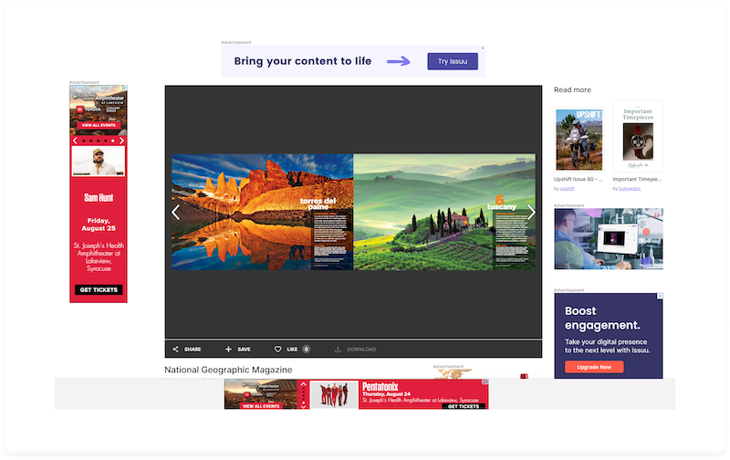
💡 Looking for Issuu alternatives?
Read more about FlippingBook compared to Issuu.
#7 Flipsnack
This digital magazine software allows you to make just a cover or a whole magazine, or convert your PDFs to online magazines and publish them online. You can also enrich your documents with multimedia: add video and audio, shopping buttons to encourage readers to buy products from your issues, and interactive captions to add/hide extra details about certain items. The interface allows you to make a simple magazine quickly, but it takes time to get used to the overwhelming number of settings and to find the ones you actually need. If you want to create content and add e-commerce options, plus are looking for online magazine hosting, such magazine creator software as Flipsnack can be exactly what you need.
Key benefits:
Interactivity: catch your readers' attention by adding links, YouTube and Vimeo videos, product tags, photo slideshows, and charts to your magazine.
Customization: create your magazines in a fast and efficient way and add free photos or your own images and fonts. You can also make your custom magazine cover and print it out.
eCommerce integration: start selling your magazines just in a few steps by integrating your digital magazines into your eCommerce store, like Shopify.
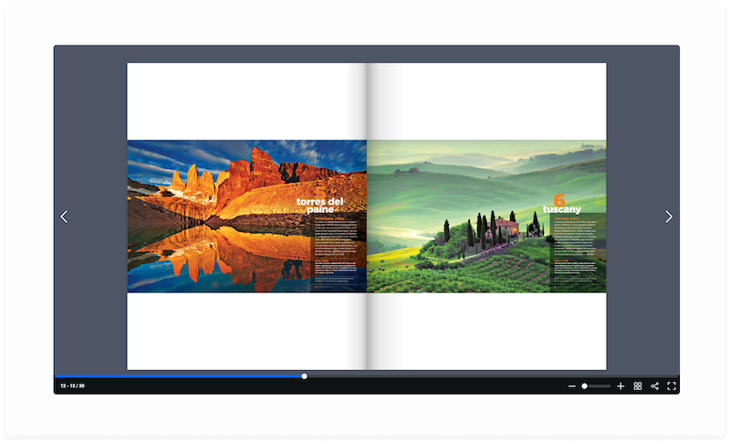
💡Check out the reasons why brands choose FlippingBook over Flipsnack.
#8 Yumpu
This online magazine platform allows you to publish and distribute digital magazines. With Yumpu, you can upload PDFs and get rich media magazines, catalogs, or brochures. Yumpu provides a page flip effect but it doesn’t have a smooth flipping mode like many other tools. Plus, the texts might look blurry after the conversion to the digital format. Yumpu also offers several sharing options on social media or websites that will help you reach a wider audience.
Key benefits:
Webkiosk: if you want to promote your magazines on a customized website, Yumpu lets you use a Webkiosk where you can apply your branding, use corporate design, publish and sell your magazines.
Publication period: set a time period when your magazine will be available for readers. After this time, the magazine will be hidden from view.
(De)activate social media sharing for others: control who can share your magazines on social media—you can activate or deactivate the sharing function for each magazine you upload.

#9 Canva
Canva is online magazine software with easy-to-use features, templates, and functionality that enables you to create magazines quickly, even if you don’t know much about design. It offers access to a wide selection of premium stock photos, videos, audio, and graphics that you can enhance your content with. Plus, Canva has many convenient design, productivity, and publishing integrations to help you improve your workflow.
Key benefits:
Social scheduling: schedule posts for Facebook, LinkedIn, Pinterest, and Twitter, directly from Canva to publish new issues of your magazines or their previews on social media right away.
Approval workflows: with collaboration tools and simple file management, magazine designs can go from ‘in review’ to ‘ready to publish’ in no time.
Built-in photo editor: edit the photos you add to your magazines in Canva—use photo tools like Background remover and Magic resize.

#10 Paperturn
With this digital magazine software, you can make interactive magazines online and get all of the attention your content deserves with video, photo, linking, sharing and website integration capabilities. However, if you have a small typeface in your magazine, it can look blurry after you convert it to an online magazine in Paperturn.
Paperturn also provides an e-commerce option: you can add a shopping cart right within your magazine.
Key benefits:
The overwrite function: easily update and make changes to your magazine or a page within your magazine while maintaining the same link you previously shared to your network—a good solution for publications that change on a monthly, quarterly, or yearly basis.
Wish list creation: when shoppers put items into their shopping cart and checkout, their wish list will be emailed to the contact of their choice (friend, family member, colleague, etc). This option is great for gift/wedding registries.
Performance stats: use Paperturn’s statistics or Google Analytics 4 integration to analyze your flipbook’s performance—allowing you to objectively measure your marketing investment and adjust your content curation.

How to Choose the Right Software
Start by asking yourself one key question: What’s your top priority? Whether it’s interactivity, monetization, design freedom, or price, knowing your main goal will help narrow down your options fast.
- Marketing teams: Choose FlippingBook for strong branding, analytics, and a polished look.
- Independent publishers: Go with Joomag or MagLoft if monetization and paywalls are essential.
- Educators and nonprofits: Try Publuu—it’s simple, affordable, and great for quick publishing.
✨ The right software isn’t about having every feature—it’s about finding the one that fits your goals and your readers best.
FAQ: Digital Magazine Software
1. Is magazine publishing software the same as a platform?
Not exactly. Software usually refers to the tool you use to create and manage your magazine (for example, FlippingBook or Publuu). A platform can mean the broader system where your content is hosted and shared—like your website or an online content hub where readers access your issues.
2. Do these tools work for subscription-based magazines?
Yes, several of them do. Tools like Joomag and MagLoft offer built-in subscription and paywall options, so you can easily monetize your content.
3. Will my content be SEO-friendly?
It can be! Many tools include SEO settings and metadata options that help your magazine appear in search results. Software like FlippingBook has a smart content promotion system that gives your content an SEO boost if you switch on Google indexing.
4. How much should I expect to spend?
Pricing varies widely: from free starter plans to premium tiers with advanced analytics and branding. Expect to pay anywhere from $20 to $200+ per month, depending on features and audience size.
This is it! We hope that our article will help you find the best digital magazine software for your business and create powerful, engaging magazines right away.





